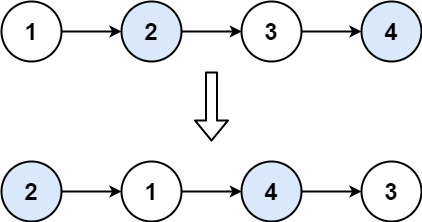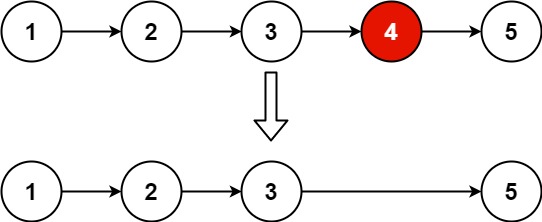LeetCodeCampsDay4链表part02
LeetCodeCampsDay4链表part02
大多修改/删除/添加操作需要使用dummy_head;仅查询的话,可以不用dummy_head
如果需要一遍扫描完成一些题目,需要借用额外的变量(时间换空间),比如多指针/快慢指针
24. 两两交换链表中的节点
https://leetcode.cn/problems/swap-nodes-in-pairs/
给你一个链表,两两交换其中相邻的节点,并返回交换后链表的头节点。你必须在不修改节点内部的值的情况下完成本题(即,只能进行节点交换)。
示例 1:
1 | 输入:head = [1,2,3,4] |
示例 2:
1 | 输入:head = [] |
示例 3:
1 | 输入:head = [1] |
提示:
- 链表中节点的数目在范围
[0, 100]内 0 <= Node.val <= 100
思路
初始化
- 需要创建dummy_head,方便解题,尤其头节点和第二个节点的交换,有dummy_head后更方便
- 如果current is None或current.next is None直接返回;说明链表为空或仅一个节点
- 需要一个pre节点,一个current节点
- 比如:[[],[1],[2],[3]]
- 令[]为dummy_head,且初始化为pre
- 令[1]为current节点
- 令[2]为tmp节点
- 令[3]为nextToGO节点(因为至少有两个节点,所以这里的[3]可能是None,不过没关系)
循环体内
- 初始化:tmp节点,指向current.next; 以及nextToGO节点,指向tmp.next
| []-> | 1-> | 2-> | 3-> | 4-> | None |
| pre | cur | tmp | nextToGO |
- 开始swap: #和交换数字的思路比较像
- pre.next = tmp
- current.next = nextToGO
- tmp.next = current
此时的链表
| []-> | 2-> | 1-> | 3-> | 4-> | None |
| pre | tmp | cur | nextToGO |
- 更新pre和current
- pre = current
- current = nextToGO
代码
- 时间复杂度 O(n)
- 空间复杂度 O(1)
1 | # Definition for singly-linked list. |
如果不使用nextToGo也可以,但需要理解好几个节点的关系
初始化
- 需要创建dummy_head,方便解题,尤其头节点和第二个节点的交换,有dummy_head后更方便
- 如果current is None或current.next is None直接返回;说明链表为空或仅一个节点
- 需要一个pre节点,一个current节点
- 比如:[[],[1],[2],[3]]
- 令[]为dummy_head,且初始化为pre
- 令[1]为current节点
- 令[2]为tmp节点
循环体内
- 初始化:tmp节点,指向current.next
| []-> | 1-> | 2-> | 3-> | 4-> | None |
| pre | cur | tmp |
- 开始swap: #和交换数字的思路比较像
- pre.next = tmp
- current.next = tmp.next
- tmp.next = current
此时的链表
| []-> | 2-> | 1-> | 3-> | 4-> | None |
| pre | tmp | cur |
- 更新pre和current
- pre = current
- current = current.next
1 | # |
19. 删除链表的倒数第 N 个结点
https://leetcode.cn/problems/remove-nth-node-from-end-of-list/
给你一个链表,删除链表的倒数第
n个结点,并且返回链表的头结点。
示例 1:
1 | 输入:head = [1,2,3,4,5], n = 2 |
示例 2:
1 | 输入:head = [1], n = 1 |
示例 3:
1 | 输入:head = [1,2], n = 1 |
提示:
- 链表中结点的数目为
sz 1 <= sz <= 300 <= Node.val <= 1001 <= n <= sz
进阶:你能尝试使用一趟扫描实现吗?
提示:Maintain two pointers and update one with a delay of n steps.
思路
- 使用dummy_head,方便解题
- 使用快慢指针,快指针比慢指针多走n+1步,因为需要让慢指针stops at 被删除节点的前一个节点;从而一次扫描即可实现
代码
- 时间复杂度 O(n)
- 空间复杂度 O(1)
1 | # Definition for singly-linked list. |
面试题 02.07. 链表相交
https://leetcode.cn/problems/intersection-of-two-linked-lists-lcci/
给你两个单链表的头节点 headA 和 headB ,请你找出并返回两个单链表相交的起始节点。如果两个链表没有交点,返回 null 。
图示两个链表在节点 c1 开始相交**:**
题目数据 保证 整个链式结构中不存在环。
注意,函数返回结果后,链表必须 保持其原始结构 。
示例 1:
1 | 输入:intersectVal = 8, listA = [4,1,8,4,5], listB = [5,0,1,8,4,5], skipA = 2, skipB = 3 |
示例 2:
1 | 输入:intersectVal = 2, listA = [0,9,1,2,4], listB = [3,2,4], skipA = 3, skipB = 1 |
示例 3:
1 | 输入:intersectVal = 0, listA = [2,6,4], listB = [1,5], skipA = 3, skipB = 2 |
提示:
listA中节点数目为mlistB中节点数目为n0 <= m, n <= 3 * 1041 <= Node.val <= 1050 <= skipA <= m0 <= skipB <= n- 如果
listA和listB没有交点,intersectVal为0 - 如果
listA和listB有交点,intersectVal == listA[skipA + 1] == listB[skipB + 1]
**进阶:**你能否设计一个时间复杂度 O(n) 、仅用 O(1) 内存的解决方案?
思路
- 可以使用dummy_head,确实方便一点儿; 不过本题目没有插入/删除,可以不用dummy_head.
- 注意它是“指针相等”而不是数值相等;并且A和B如果相交,它们则一定是到某个节点后,是指向同一节点的,不要把它们当成两条完全独立的链表处理;
- 可以通过判断最后一个元素是否相等来初步筛选
- 如果两个链表长度相等,则可以同步地遍历,找到共同节点
- 如果两个链表长度不相等,可以让长的先遍历n步n = abs(L_A - L_B), where L_A is the length of A. 然后再按长度相等的方式处理
代码
- 时间复杂度:O(L_A + L_B) [指A和B的总长度]
- 空间复杂度:O(1)
1 | # Definition for singly-linked list. |
142. 环形链表 II
https://leetcode.cn/problems/linked-list-cycle-ii/
给定一个链表的头节点
head,返回链表开始入环的第一个节点。 如果链表无环,则返回null。
如果链表中有某个节点,可以通过连续跟踪 next 指针再次到达,则链表中存在环。 为了表示给定链表中的环,评测系统内部使用整数 pos 来表示链表尾连接到链表中的位置(索引从 0 开始)。如果 pos 是 -1,则在该链表中没有环。注意:pos 不作为参数进行传递,仅仅是为了标识链表的实际情况。
不允许修改 链表。
示例 1:
1 | 输入:head = [3,2,0,-4], pos = 1 |
示例 2:
1 | 输入:head = [1,2], pos = 0 |
示例 3:
1 | 输入:head = [1], pos = -1 |
提示:
- 链表中节点的数目范围在范围
[0, 104]内 -105 <= Node.val <= 105pos的值为-1或者链表中的一个有效索引
**进阶:**你是否可以使用 O(1) 空间解决此题?
快慢指针思路
- 这题不用dummy_head
- 本题有两个任务:
- 是否有环
- 如果有环,怎么找到环的入口
是否有环
如果使用快慢指针的方式,快指针每次走两步,慢指针每次走一步,如果有环,一定能相遇
如何找环的入口
- 令头节点到入口节点的距离为x(个节点)。
- 环形入口节点 到 fast指针与slow指针相遇节点 节点数为y。
- 从相遇节点 再到环形入口节点节点数为 z。
如图所示:
那么相遇时:
- slow指针走过的节点数为:
x + y - fast指针走过的节点数:
x + y + n (y + z),n为fast指针在环内走了n圈才遇到slow指针,(y+z)为 一圈内节点的个数A。
因为fast指针是一步走两个节点,slow指针一步走一个节点, 所以 fast指针走过的节点数 = slow指针走过的节点数 * 2 :
两边消掉一个(x+y): x + y = n (y + z)
因为要找环形的入口,则需要求的元素是
x,因为x表示:the distance between 头节点 and 入口节点。即x = n (y + z) - y
再从n(y+z)中提出一个 (y+z)来,整理公式之后为如下公式:x = (n - 1) (y + z) + z 注意这里n一定是大于等于1的,因为 fast指针至少要多走一圈才能相遇slow指针。
这个公式说明什么呢?
先拿n为1的情况来举例,意味着fast指针在环形里转了一圈之后,就遇到了 slow指针了。
当 n为1的时候,公式就化解为 x = z,
这就意味着,从头结点出发一个指针,从相遇节点也出发一个指针,这两个指针每次都只走一个节点, 那么当这两个指针相遇的时候就是 环形入口的节点。
也就是在相遇节点处,定义一个指针index1,在头结点处定一个指针index2(也可以让slow继续走,并且让fast每次只走一步)
让index1和index2同时移动,每次移动一个节点, 那么他们相遇的地方就是 环形入口的节点。
动画如下:
那么 n如果大于1是什么情况呢,就是fast指针在环形转n圈之后才遇到 slow指针。
其实这种情况和n为1的时候 效果是一样的,一样可以通过这个方法找到 环形的入口节点,只不过,index1 指针在环里 多转了(n-1)圈,然后再遇到index2,相遇点依然是环形的入口节点。
代码
- 时间复杂度 O(N) --slow走完一遍即可(slow不用在环内转圈)/60ms
- 空间复杂度 O(1)
1 | # Definition for singly-linked list. |
普通思路
创建一个visited_list,将遍历过的节点都添加进去,如果新的节点已经存在于visited_list说明它就是“入口节点”
代码
- 时间复杂度 O(N)—844ms
- 空间复杂度 O(N)
1 | # Definition for singly-linked list. |



















